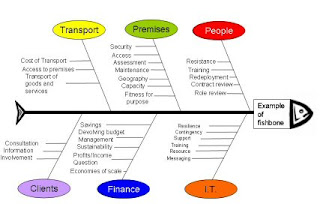12. Project Procurement Management
In this post, we are going to focus on the importance of project procurement management and the increasing use of outsourcing for information technology projects. The term procurement means acquiring goods and/or services from an outside source. There are different ideas about outsourcing. Some companies, such as Wal-Mart, prefer to do no outsourcing at all, while others do a lot of outsourcing. But why do companies outsource? There are different reasons among which we may rank:
importance of project procurement management and the increasing use of outsourcing for information technology projects. The term procurement means acquiring goods and/or services from an outside source. There are different ideas about outsourcing. Some companies, such as Wal-Mart, prefer to do no outsourcing at all, while others do a lot of outsourcing. But why do companies outsource? There are different reasons among which we may rank:
a) To reduce both fixed and recurrent costs,
b) To allow the client organization to focus on its core business,
c) To access skills and technologies,
d) To provide flexibility,
e) To increase accountability.
The main key of outsourcing is the contract, which is a mutually binding agreement that obligates the seller to provide the specified products or services and obligates the buyer to pay for them.
Project procurement management means acquiring goods and services for a project from outside the performing organization. Processes involved in this include:
Planning Purchases and Acquisitions: includes identifying which project needs can best be met by using products or services outside the organization.
Planning Contracting: Involves preparing several documents needed for potential sellers to prepare their responses and determining the evaluation criteria for the contract award. Two are the main documents involved in this process:
i) Request for Proposals: which is a document prepared by a seller when there are different approaches for meeting buyer needs. And secondly,
ii)Requests for Quotes: which is a document prepared by sellers providing pricing for standard items that have been clearly defined by the buyer.
Requesting Seller Responses: is the process of deciding whom to ask to do the work, sending appropriate documentation to potential sellers, and obtaining proposals or bids.
Selecting Sellers: This process is also known as source selection. It includes choosing from among potential suppliers through a process of evaluating potential sellers and negotiating the contract. A sample of "Proposal Evaluation Sheet" is shown in the picture on the left.
It includes choosing from among potential suppliers through a process of evaluating potential sellers and negotiating the contract. A sample of "Proposal Evaluation Sheet" is shown in the picture on the left.
Administering the Contract: Ensures that the seller’s performance meets contractual requirements. It is critical that project managers and team members watch for constructive change orders, which are oral or written acts or omissions by someone with actual or apparent authority that can be construed to have the same effect as a written change order. And lastly,
Closing the Contract: This involves completing and settling contracts and resolving any open items.
The project team should:
a) Determine if all work was completed correctly and satisfactorily
b) Update records to reflect final results
c) Archive information for future use
d) The contract itself should include requirements for formal acceptance and closure
 importance of project procurement management and the increasing use of outsourcing for information technology projects. The term procurement means acquiring goods and/or services from an outside source. There are different ideas about outsourcing. Some companies, such as Wal-Mart, prefer to do no outsourcing at all, while others do a lot of outsourcing. But why do companies outsource? There are different reasons among which we may rank:
importance of project procurement management and the increasing use of outsourcing for information technology projects. The term procurement means acquiring goods and/or services from an outside source. There are different ideas about outsourcing. Some companies, such as Wal-Mart, prefer to do no outsourcing at all, while others do a lot of outsourcing. But why do companies outsource? There are different reasons among which we may rank: a) To reduce both fixed and recurrent costs,
b) To allow the client organization to focus on its core business,
c) To access skills and technologies,
d) To provide flexibility,
e) To increase accountability.
The main key of outsourcing is the contract, which is a mutually binding agreement that obligates the seller to provide the specified products or services and obligates the buyer to pay for them.
Project procurement management means acquiring goods and services for a project from outside the performing organization. Processes involved in this include:
Planning Purchases and Acquisitions: includes identifying which project needs can best be met by using products or services outside the organization.
Planning Contracting: Involves preparing several documents needed for potential sellers to prepare their responses and determining the evaluation criteria for the contract award. Two are the main documents involved in this process:
i) Request for Proposals: which is a document prepared by a seller when there are different approaches for meeting buyer needs. And secondly,
ii)Requests for Quotes: which is a document prepared by sellers providing pricing for standard items that have been clearly defined by the buyer.
Requesting Seller Responses: is the process of deciding whom to ask to do the work, sending appropriate documentation to potential sellers, and obtaining proposals or bids.
Selecting Sellers: This process is also known as source selection.
 It includes choosing from among potential suppliers through a process of evaluating potential sellers and negotiating the contract. A sample of "Proposal Evaluation Sheet" is shown in the picture on the left.
It includes choosing from among potential suppliers through a process of evaluating potential sellers and negotiating the contract. A sample of "Proposal Evaluation Sheet" is shown in the picture on the left. Administering the Contract: Ensures that the seller’s performance meets contractual requirements. It is critical that project managers and team members watch for constructive change orders, which are oral or written acts or omissions by someone with actual or apparent authority that can be construed to have the same effect as a written change order. And lastly,
Closing the Contract: This involves completing and settling contracts and resolving any open items.
The project team should:
a) Determine if all work was completed correctly and satisfactorily
b) Update records to reflect final results
c) Archive information for future use
d) The contract itself should include requirements for formal acceptance and closure



Comments